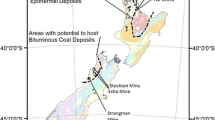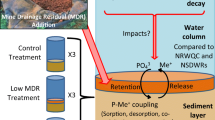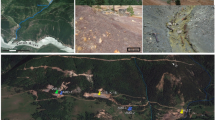Abstract
Metal contamination of the water in two streams was investigated at the Ramshorn Mine along Bayhorse Creek in Idaho, and the Pacific Mine along the North Fork of the American Fork River in Utah. The studies were conducted to determine what remediation measures should be implemented at each site to reduce metal loads in the streams. Discharge measurements and chemical analyses of filtered and unfiltered water samples allowed dissolved and total metal loads to be calculated. Copper, Fe, Mn, Pb, Zn, and As were found at both sites, and Cd also was present at the Utah site. Of these, Fe had the highest dissolved and total loading rates at the Ramshorn Mine, with Mn and Zn having intermediate rates; Fe and Zn had the highest loading rates at the Pacific Mine. Hydrous ferric oxides, particularly ferrihydrite, are abundant at both sites. Pyrite is the iron source at the Pacific Mine, while it is siderite at the Ramshorn Mine. The lack of sulfide at the latter site inhibits acid mine drainage (AMD) formation, and the presence of dolomite provides abundant alkalinity to neutralize any AMD that might be generated. PHREEQC was used to gain insight into the metal phases and oxidation states, to calculate saturation indices, and to perform surface sorption modeling. The results suggest that most of the metals at both sites are transported in the suspended rather than dissolved state, As occurs exclusively in the less toxic As5+ form, and several metals are likely sorbed to ferrihydrite. Based in part on the results of these studies, the US Forest Service removed the tailings at the Pacific Mine site, but only capped and regraded the tailings pile at the Ramshorn Mine.
Zusammenfassung
Untersucht wurde die Metallbelastung zweier Oberflächengewässer, und zwar im Bereich der Ramshorn Mine entlang des Bayhorse Creek in Idaho sowie im Gebiet der Pacific Mine entlang des nördlichen Arms des American Fork River in Utah. Die Untersuchungen dienten der Ableitung von Sanierungsmaßnahmen mit dem Ziel der Reduzierung der Metallfrachten an beiden Standorten. Abflussmessungen und chemische Analysen von filtrierten und unfiltrierten Wasserproben ermöglichten die Berechnung von Gelöst- und Gesamtmetallfrachten. Kupfer, Fe, Mn, Pb, Zn und As wurden an beiden Standorten gefunden, an der Mine in Utah trat zusätzlich Cd auf. Von all diesen Metallen wies an der Ramshorn Mine Fe die höchsten Gelöst- und Gesamtfrachten auf, bei mittleren Frachten für Mn und Zn; im Bereich der Pacific Mine waren Fe und Zn die Metalle mit dem höchsten Frachtaustrag. Eisenoxidhydrate, insbesondere Ferrihydrit, treten an beiden Standorten in großen Mengen auf. Während im Bereich der Pacific Mine Pyrit die Eisenquelle darstellt, ist Siderit für den Eisenaustrag an der Ramshorn Mine verantwortlich. Bei letzterer verhindert das Fehlen von Sulfid die Sauerwasserbildung (AMD), und das Vorhandensein von Dolomit liefert hinreichend Alkalität zur Neutralisation sich eventuell bildender Säure. PHREEQC wurde eingesetzt zur Bestimmung von Metallphasen, Oxidationsstufen und Sättigungsindizes sowie zur Modellierung der Oberflächenkomplexierung. Die Ergebnisse weisen darauf hin, dass die Metalle an beiden Standorten vorrangig als Schwebstoffe und nicht als Gelöstphasen transportiert werden, dass As ausschließlich als wenier toxisches As5+ auftritt, und dass diverse Metalle wahrscheinlich an Ferrihydrit sorbiert werden. U. a. auf Basis der hier vorgestellten Ergebnisse entschied sich der U.S. Forest Service, die Tailings am Standort der Pacific Mine umzulagern, wohingegen die bergbaulichen Rückstände an der Ramshorn Mine lediglich konturiert und abgedeckt wurden.
Resumen
Se investigó la contaminación con metales del agua en dos cursos de agua en la mina Ramshorn a lo largo de Bayhorse Creek en Idaho y en la Pacific Mine a lo largo del North Fork del río American Fork en Utah. Los estudios se llevaron a cabo para determinar qué medidas de remediación deberían implementarse en cada sitio para reducir las cargas de metales en las corrientes. Las mediciones de descarga y los análisis químicos de muestras de agua filtrada y sin filtrar, permitieron calcular las cargas de metal disuelto y total. Cu, Fe, Mn, Pb, Zn y As se encontraron en ambos sitios y Cd también estuvo presente en el sitio de Utah. De estos, Fe tuvo las mayores tasas de carga disuelta y total en la Mina Ramshorn y Mn y Zn con tasas intermedias; Fe y Zn tuvieron las tasas de carga más altas en Pacific Mine. Los óxidos férricos hidratados, en particular la ferrihidrita, son abundantes en ambos sitios. La pirita es la fuente de hierro en la mina Pacific, mientras que lo es siderita en la mina Ramshorn. La falta de sulfuro en este último sitio inhibe el ácido la formación de drenaje de minas (AMD) y la presencia de dolomita proporciona una alcalinidad abundante para neutralizar cualquier AMD que pueda generarse. PHREEQC se usó para obtener información sobre las fases del metal y los estados de oxidación, calcular los índices de saturación y realizar el modelado de sorción de la superficie. Los resultados sugieren que la mayoría de los metales en ambos sitios se transporta en estado suspendido más que disuelto, As aparece exclusivamente en la forma pentavalente que es menos tóxica y varios metales están probablemente adsorbidos a ferrihidrita. En parte basado en los resultados de estos estudios, el Servicio Forestal de EEUU eliminó los relaves en el sitio de la Mina Pacific, pero solo redistribuyó y tapó la pila de relaves en la Mina Ramshorn.
抽象
研究了Ramshorn矿对爱达荷州Bayhorse河水和Pacific矿对犹他州Fork河北Fork支流的金属污染。研究旨在提出减轻河流金属污染荷载的修复措施。通过测量废水流量和化学分析过滤、非过滤水样,得以计算溶解态金属荷载和总金属荷载。两个研究场地都测试出铜、铁、锰、铅、锌和砷,犹他州研究场地还发现镉。铁在Ramshorn矿具有最高溶解态金属荷载率和总荷载率,锰和锌荷载率中等。铁和锌在Pacific矿载荷率最高。两个场地都含丰富的含水铁氧化物,尤其是水铁矿。Pacific矿的铁源于黄铁矿,Ramshorn矿源于菱铁矿。后者因缺少硫化物抑制了酸性废水生成,同时白云石碱度也能中和任何可能产生的酸。利用PHREEQC深入分析了金属相态和氧化态,计算了矿物饱和系数,建立了表面吸附模型。结果表明,多数金属在两矿以悬浮态为主,而不是溶解态。几种金属可能吸附于水铁矿。在一定程度上,基于以上研究结果,美国森林保养部门除去了Pacific矿的尾矿,仅对Ramshorn矿尾矿进行覆盖和重新分级。



Similar content being viewed by others
References
Allison JD, Brown DS, Novo-Gradac KJ (1990) MINTEQA2/PRODEFA2—a geochemical assessment model for environmental systems—version 3.0 user’s manual. U.S. Environmental Protection Agency (USEPA), Office of Research and Development, Environmental Research Laboratory, Athens
Alpers CN, Blowes DW (1994) Environmental geochemistry of sulfide oxidation. ACS Symposium Series 550, American Chemical Soc, Washington, DC
Burk NI (2004) Geochemistry of groundwater–surface water interactions and metals loading rates in the North Fork of the American Fork River, Utah, from an abandoned silver/lead mine. MS thesis, Utah State Univ, Logan
Calkins FC, Butler BS, Heikes VC (1943) Geology and ore deposits of the Cottonwood-American Fork area, Utah. U.S. Geological Survey (USGS), Professional Paper 201, Washington, DC
Crosland RI, Thompson C (1994) Heritage resource inventory of American Fork area mine closures, Utah County, Utah, final report. U.S. Forest Service (USFS), Uinta National Forest, South Jordan
Dzombak DA, Morel FMM (1990) Surface complexation modeling: hydrous ferric oxide. Wiley, New York City
Ecology, Environment I (2010) Draft removal site evaluation report, Ramshorn Mine site, Custer County, Idaho. Idaho Dept of Environmental Quality Contract EP-S7-06-02, Technical Direction 08-08-0006, Seattle
Evangelou VP (1995) Pyrite oxidation and its control. CRC, Boca Raton
Evangelou VP, Zhang YL (1995) A review: pyrite oxidation mechanisms and acid mine drainage prevention. Crit Rev Environ Sci Technol 25:141–199
Ferguson JF, Gavis J (1972) A review of the arsenic cycle in natural waters. Water Res 6:1259–1274
Fitzgerald TV (2000) American Fork Canyon watershed reclamation project—community relations plan. U.S. Forest Service, Uinta National Forest
Gray NF (1996) Field assessment of acid mine drainage contamination in surface and ground water. Environ Geol 27:358–361
IDEQ (Idaho Dept of Environmental Quality) (2003) Ramshorn Mine preliminary assessment report. IDEQ, Seattle
INAP (International Network for Acid Prevention) (2009) GARD (Global Acid Rock Drainage) Guide. http://www.gardguide.com/index. Accessed Dec 2017
Jambor JL, Blowes DW (1994) Environmental geochemistry of sulfide mine wastes. Mineralogical Assoc of Canada, Short Course 22, Ottawa
Jambor JL, Blowes DW (1998) Theory and application of mineralogy in environmental studies of sulfide bearing mine wastes. In: Cabri LJ, Vaughn DJ (eds) Modern approaches to ore and environmental mineralogy. Mineralogical Assoc of Canada Short Course 27, Ottawa
Johnson, JE (no date) American Fork Canyon: as I remember it in the past. U.S. Forest Service, Uinta National Forest, South Jordan
Keetch F (1978) Mining developments in the American Fork district. U.S. Forest Service, Uinta National Forest, South Jordan
Keith CN, Vaughn DJ (2000) Mechanisms and rates of sulphide oxidation in relation to the problems of acid rock (mine) drainage. In: Cotter-Howells JD, Campbell LS, Valsami-Jones E, Batchelder M (eds) Environmental mineralogy: microbial interactions, anthropogenic influences, contaminated land and waste management, mineralogical series 9. Mineralogical Soc, London, pp 117–139
Lachmar TE, Burk NI, Kolesar PT (2006) Groundwater contribution of metals from an abandoned mine to the North Fork of the American Fork River, Utah. Water Air Soil Poll 173:103–120
Ludlow AB (2001) Trace element biogeochemistry of a wetland system receiving mine drainage. MS thesis, Utah State Univ, Logan
McDonough HL (2015) Groundwater and surface water contributions to metals loading in Bayhorse Creek at the abandoned Ramshorn Mine site near Bayhorse, Idaho. MS thesis, Utah State Univ, Logan
Mitchell VE (1999) History of mines in the Bayhorse Creek area, Custer County, Idaho. Idaho Geological Survey. Staff Report 99–8, Moscow
Nordstrom DK, Alpers CN (1999) Geochemistry of acid mine waters. Rev Econ Geol 6A:133–160
Parkhurst DL, Appelo CA (2000) User’s guide to PHREEQC (version 2)—a computer program for speciation, batch-reaction, one-dimensional transport, and inverse geochemical calculations. U.S. Geological Survey, Water-Resources Investigation Report 99-4259, Washington, DC, p 160
Plumlee GS, Smith KS, Montour MR, Ficklin WH, Mosier EL (1999) Geologic controls on the composition of natural waters and mine waters draining diverse mineral-deposit types. Rev Econ Geol 6A:373–432
Ross CP (1937) Geology and ore deposits of the Bayhorse region, Custer County, Idaho. USGS, Bull 877, Washington DC
Salomons W (1995) Environmental impact of metals derived from mining activities: processes, prediction, prevention. J Geochem Explor 52:5–23
Seal B, Rye SJ (1992) Stable isotope study of water-rock interaction and ore formation, Bayhorse base and precious metal district, Idaho. Econ Geol 87:271–287
Skipp B (1987) Basement thrust sheets in the Clearwater orogenic zone, central Idaho and western Montana. Geology 15:220–224
Smith KS (1999) Metal sorption on mineral surfaces: an overview with examples relating to mineral deposits. Rev Econ Geol 6A:161–182
Soil & Plant Analysis Laboratory (2005) Analysis of major, minor and trace elements in soil and sediment samples with ICP-OES and ICP-MS, standard operation procedure. Univ of Wisconsin, Madison
Stauffer AC (1971) Histories of American Fork Canyon. USFS, Uinta National Forest, South Jordan
Stumm W, Morgan JJ (1996) Aquatic chemistry. Wiley, New York City
Tordo GM, Baker AJM, Willis AJ (2000) Current approaches to the revegetation and reclamation of metalliferous mine wastes. Chemoshpere 41:219–228
UDOGM (Utah Div of Oil, Gas, and Mining) (1993) American Fork hydrology and water quality study. Utah Dept of Natural Resources, Salt Lake City
USEPA (2000) Liquid assets: America’s water resources at a turning point: water. http://epa.gov/lawsregs/lawsguidance/cwa/economics/liquidassets/index.cfm. Accessed 3 June 2013
USGS (1980) National handbook of recommended methods for water-data acquisition. Office of Water Data Acquisition, Reston
USGS (1995) Brighton quadrangle 1 meter DOQ. Autom Geogr Resour Cent Utah Scale 1:24000
Wells MW (1983) Gold camps & silver cities. Idaho Bureau of Mines and Geology, Bulletin 22, Moscow
Worl RG, Wilson AB, Smith CL, Kleinkopf MD, Skyles RC (1989) Mineral resource potential and geology of the Challis National Forest, Idaho. USGS Bull 1873, Washington DC
Acknowledgements
Funding for the Ramshorn Mine investigation was provided by the U.S. Forest Service (Cost Share Agreement #11-CS-11046000-014). This investigation is dedicated in honor of Ms. Martha (Maggie) Baker, who was instrumental in securing the funds. The authors also express our appreciation for the support and assistance extended by Mr. Dean Morgan. Finally, the authors thank the two anonymous reviewers and the editors, whose insights and suggestions greatly improved the final version of this work.
Author information
Authors and Affiliations
Corresponding author
Rights and permissions
About this article
Cite this article
Lachmar, T.E., McDonough, H.L., Burk, N.I. et al. Effect of Ore Mineralogy and Bedrock Lithology on Metal Loading Rates and Acid-Mine Drainage: Bayhorse Creek, Idaho and the North Fork of the American Fork River, Utah. Mine Water Environ 38, 3–15 (2019). https://doi.org/10.1007/s10230-018-00574-1
Received:
Accepted:
Published:
Issue Date:
DOI: https://doi.org/10.1007/s10230-018-00574-1




